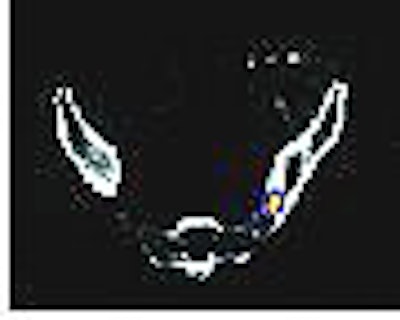
There's no shortage of research on SPECT/CT in oncologic imaging and the fact that bone scintingraphy has its limitations in this setting. But what about patients who are referred for nononcologic imaging? Is bone scintigraphy any more useful? No, according to nuclear medicine specialists from Israel, who advocated using SPECT plus multislice low-dose CT (MslCT) instead.
Dr. Einat Even-Sapir, Ph.D., and colleagues enrolled 76 patients in a six-month prospective study. All of patients had focal sites of increased uptake on Tc-99m diphosphonate SPECT. Pain was the main indication for a bone scintigraphy referral.
Instead, they underwent SPECT/MslCT on a hybrid SPECT/CT system composed of an inline dual-head gamma camera and a four-slice low-dose CT (Infinia/Hawkeye 4, GE Healthcare, Chalfont St. Giles, U.K.). SPECT/MslCT images were read in consensus by two nuclear medicine physicians and a musculoskeletal radiologist.
"To improve resolution and signal-to-noise characteristics, SPECT data were reconstructed using a novel collimator-detection response method (Evolution software package, GE Healthcare), which incorporates a quantitative model of collimator-detector response function of the acquisition system into an iterative reconstruction algorithm," wrote Even-Sapir's group from Tel Aviv Sourasky Medical Center and Tel Aviv University (Journal of Nuclear Medicine, February 2007, Vol. 48:2, pp. 319-324).
According to the results, in 59% of the patients, the final diagnosis was reached using SPECT/MslCT and no additional imaging was required. The diagnoses included fractures, osteochondral lesions, herniation pit, osteoid osteoma, and vertebral collapse.
In 11 patients, adding CT did not offer better clinical information as a clear morphologic abnormality was not seen. However, SPECT/MslCT did accurately localize nonspecific lesions in 30% of the patients, offering guidance as to the next appropriate imaging exam, the authors stated.
For example, "MRI was beneficial as the next imaging modality after SPECT/MslCT in the case of migratory osteoporosis, early stages of infection, and malignant involvement of the marrow," they explained.
 |
| Diagnosis of incidental scintigraphic abnormality in 48-year-old patient referred for bone scintigraphy due to painful right hip joint. Transaxial SPECT/CT slices; from left to right: MslCT, SPECT, and fused images. Incidental focal increased uptake was detected in left iliac bone. CT finding, which corresponds in location with scintigraphic abnormality, is that of a calcified chondroid matrix representing a nonsymptomatic enchondroma (arrow). Cause of patient's right hip pain was idiopathic osteoporosis (not shown). Reprinted by permission of the Society of Nuclear Medicine. |
Using SPECT/MslCT could obviate the need for full-dose CT as part of bone scintigraphy follow-up, the authors concluded. In their series, the hybrid modality also offered more specific diagnosis than bone scintigraphy.
This application of molecular and anatomic imaging could produce a major shift in nononcologic imaging, as other studies have pointed out that not all modalities are suitable for bone diseases. A review paper by researchers from the University of Amsterdam stated that x-rays were not wholly reliable as a standalone modality for diagnosing stress fractures. They also stated CT should be used routinely in this setting and that MRI has proved superior to bone scintigraphy for second-line testing (European Journal of Radiology, February 19, 2007).
By Shalmali Pal
AuntMinnie.com staff writer
March 23, 2007
Related Reading
Scintigraphy pegs potential responders to plantar fasciitis treatment, October 25, 2006
Experimental CAD scheme makes quick work of bone scintigraphy analysis, June 5, 2006
Bone SPECT identifies patients who would benefit from facet joint injection, February 15, 2006
Copyright © 2007 AuntMinnie.com




















